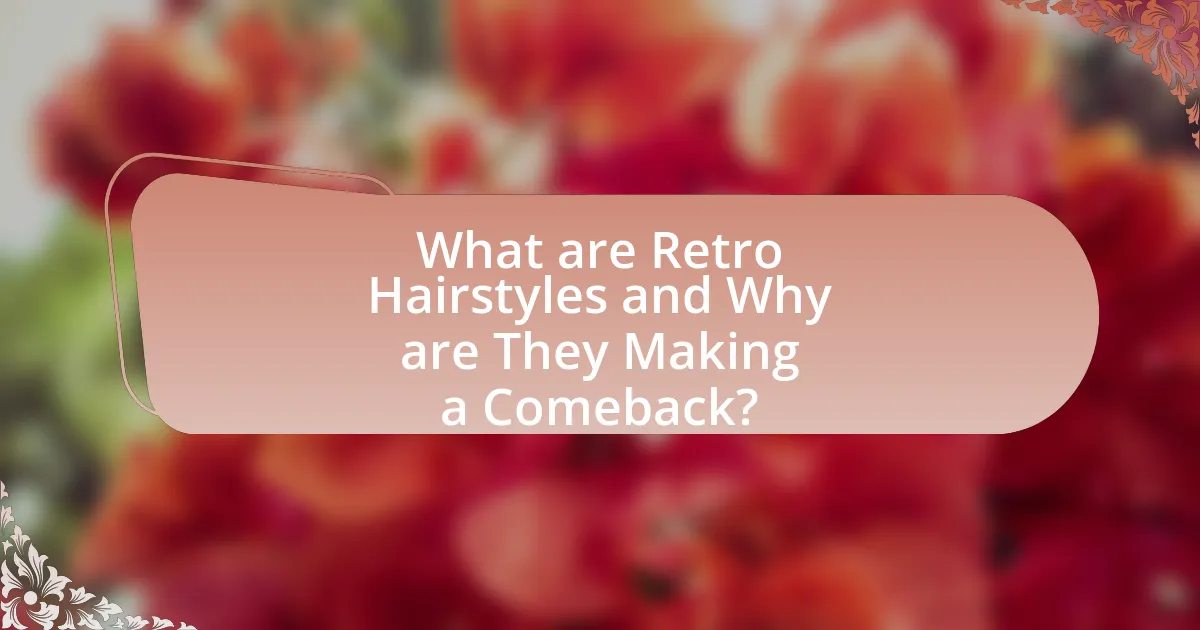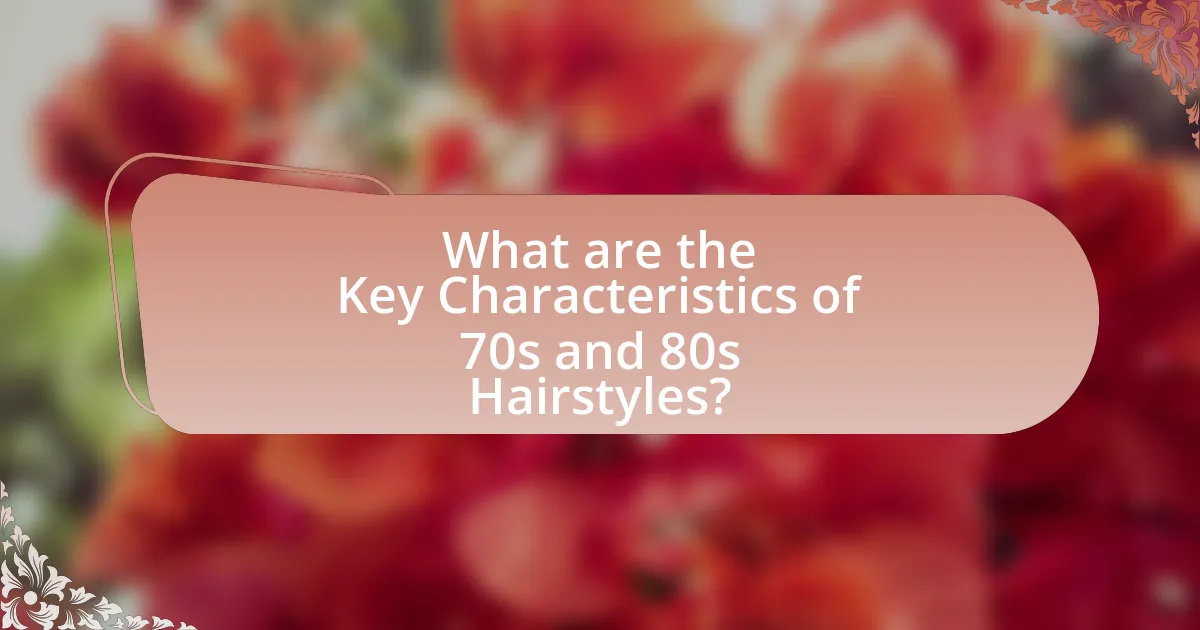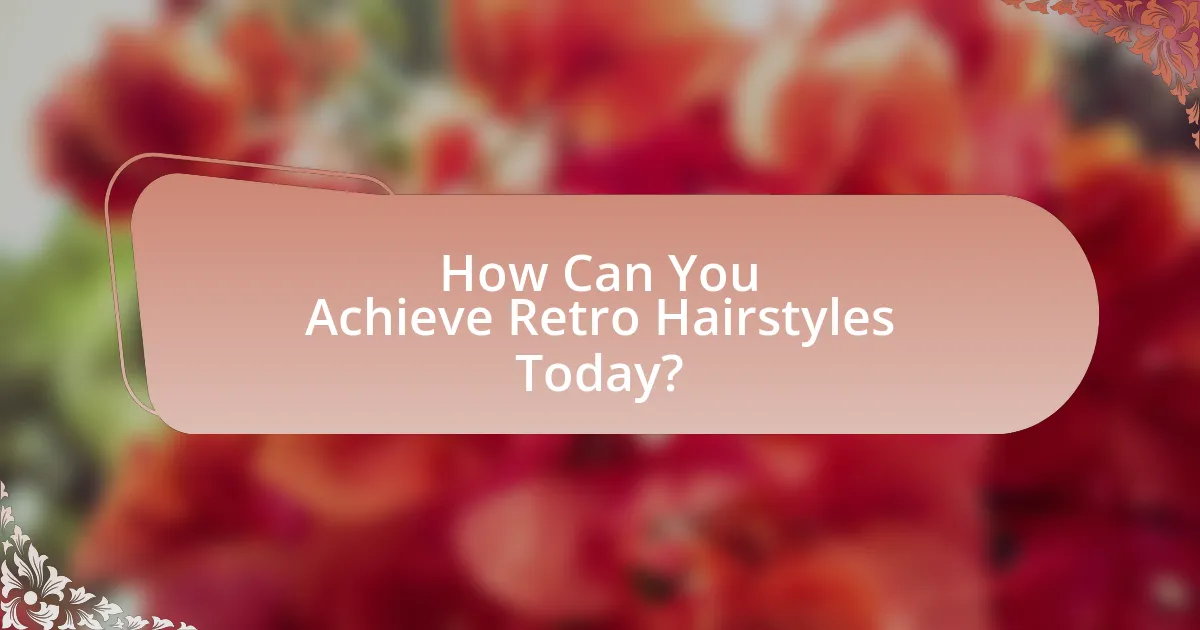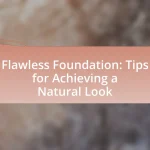Retro hairstyles, particularly those from the 1970s and 1980s, are experiencing a resurgence in contemporary fashion, driven by nostalgia and the influence of social media. Key styles such as the shag haircut, mullet, and voluminous curls are gaining popularity, reflecting a cultural revival that emphasizes individuality and self-expression. The article explores how these hairstyles have influenced modern trends, the role of celebrities in their resurgence, and the techniques and products necessary to recreate these iconic looks. Additionally, it discusses the impact of face shape on hairstyle selection and offers tips for maintaining the longevity of retro styles.

What are Retro Hairstyles and Why are They Making a Comeback?
Retro hairstyles are hair trends that originated in the 1970s and 1980s, characterized by distinctive styles such as big curls, feathered layers, and bold colors. These hairstyles are making a comeback due to a resurgence of interest in vintage fashion, driven by social media platforms showcasing nostalgic aesthetics and the cyclical nature of fashion trends. The popularity of retro hairstyles is further supported by celebrities and influencers who adopt these styles, reinforcing their appeal among younger generations seeking unique and expressive looks.
How did the 70s and 80s influence modern hairstyle trends?
The 70s and 80s significantly influenced modern hairstyle trends by introducing bold colors, volume, and unique textures that are now prevalent in contemporary styles. The 70s popularized hairstyles like feathered cuts and shaggy layers, which emphasize movement and texture, while the 80s brought about the iconic big hair and perm styles, characterized by their volume and curls. These elements have resurfaced in today’s fashion, as seen in the revival of layered cuts and vibrant hair colors, reflecting a nostalgic yet modern aesthetic. The cyclical nature of fashion ensures that these retro influences continue to shape current trends, demonstrating their lasting impact on hairstyling.
What specific hairstyles from the 70s and 80s are popular today?
Specific hairstyles from the 70s and 80s that are popular today include the shag haircut, the mullet, and big, voluminous curls. The shag haircut, characterized by its layered texture and choppy ends, has seen a resurgence due to its versatility and retro appeal. The mullet, known for its short front and long back, has been embraced by various celebrities, making it a trendy choice once again. Additionally, big curls reminiscent of the 80s, often achieved with curling irons or rollers, are favored for their bold and glamorous look. These hairstyles reflect a nostalgic return to the bold aesthetics of those decades, appealing to both younger generations and those who experienced the original trends.
Why do people gravitate towards retro hairstyles in contemporary fashion?
People gravitate towards retro hairstyles in contemporary fashion due to a combination of nostalgia, cultural revival, and the desire for individuality. Nostalgia plays a significant role as individuals often seek to reconnect with the aesthetics of past decades, particularly the 70s and 80s, which are characterized by bold and expressive styles. Cultural revival is evident as fashion cycles tend to revisit previous trends, making retro hairstyles a popular choice among designers and influencers. Additionally, these hairstyles allow individuals to express their uniqueness and stand out in a sea of modern styles, as retro looks often incorporate vibrant colors and distinctive shapes. The resurgence of platforms like social media has further amplified this trend, enabling the sharing and celebration of vintage-inspired looks, thus reinforcing their appeal in contemporary fashion.
What cultural factors contribute to the resurgence of retro hairstyles?
The resurgence of retro hairstyles is primarily driven by nostalgia and the influence of pop culture. Nostalgia for past decades, particularly the 1970s and 1980s, is prevalent in contemporary society, as seen in the popularity of vintage fashion and music. This cultural phenomenon is reinforced by media representations, such as television shows and films that celebrate these eras, leading to a revival of styles like the mullet and big hair. Additionally, social media platforms amplify this trend, allowing users to share and promote retro looks, further embedding these hairstyles into current fashion. The combination of nostalgia, media influence, and social media engagement creates a strong cultural impetus for the revival of retro hairstyles.
How does nostalgia play a role in hairstyle choices?
Nostalgia significantly influences hairstyle choices by prompting individuals to revisit and adopt styles from past decades, particularly the 70s and 80s. This phenomenon occurs as people associate these hairstyles with positive memories and cultural moments, leading to a resurgence in popularity. For example, the revival of styles like the mullet and big hair reflects a collective yearning for the aesthetics and cultural identity of those eras, as evidenced by fashion trends and social media platforms showcasing retro looks. Studies indicate that nostalgia can enhance mood and foster a sense of belonging, further driving the desire to emulate past hairstyles.
What impact do celebrities and influencers have on this trend?
Celebrities and influencers significantly drive the resurgence of retro hairstyles from the 70s and 80s. Their visibility on social media platforms showcases these styles, leading to increased public interest and adoption. For instance, when high-profile figures like Dua Lipa and Harry Styles sported shag cuts and mullets, searches for these hairstyles surged by over 200% on platforms like Pinterest. This phenomenon illustrates how celebrity endorsements can transform niche trends into mainstream fashion, influencing consumer behavior and hairstyling choices across demographics.

What are the Key Characteristics of 70s and 80s Hairstyles?
The key characteristics of 70s and 80s hairstyles include volume, boldness, and distinct shapes. In the 1970s, hairstyles often featured long, flowing locks, feathered layers, and natural textures, exemplified by styles like the shag and the Farrah Fawcett flip. The 1980s introduced even more dramatic elements, such as big hair achieved through teasing, perms, and the use of hairspray, with iconic styles like the mullet and side ponytail becoming popular. These decades emphasized individuality and self-expression, with vibrant colors and accessories often enhancing the overall look.
What are the defining features of 70s hairstyles?
The defining features of 70s hairstyles include long, flowing locks, often styled with layers and volume, as well as the popularity of natural textures and curls. During this decade, hairstyles such as the shag cut, feathered styles, and afros became iconic, reflecting the era’s emphasis on individuality and self-expression. The use of hair accessories, such as headbands and clips, was also prevalent, enhancing the overall aesthetic. These styles were influenced by cultural movements, including the rise of rock music and the feminist movement, which encouraged women to embrace their natural beauty and personal style.
How do volume and texture define 70s hairstyles?
Volume and texture are defining characteristics of 70s hairstyles, as they create a bold and dynamic appearance. The era is marked by styles that emphasize large, voluminous shapes, often achieved through techniques like layering and the use of products such as mousse and hairspray. For instance, the iconic shag haircut features choppy layers that enhance both volume and texture, allowing for movement and a carefree look. Additionally, the popularity of curls and waves during this decade contributed to the overall aesthetic, with styles like the Farrah Fawcett feathered look showcasing how texture can add depth and dimension. These elements combined to form a signature style that is instantly recognizable and has influenced modern hair trends.
What iconic styles emerged during the 70s?
Iconic styles that emerged during the 70s include bell-bottom jeans, platform shoes, and bohemian fashion. These styles were characterized by their bold colors, patterns, and a sense of freedom in expression. Bell-bottom jeans became a symbol of the counterculture movement, while platform shoes were popularized by disco culture, reflecting the era’s emphasis on nightlife and dance. Bohemian fashion, with its flowing fabrics and ethnic prints, represented a departure from traditional styles, embracing individuality and artistic expression.
What are the defining features of 80s hairstyles?
80s hairstyles are characterized by volume, boldness, and distinctive shapes. Prominent features include big hair achieved through teasing and the use of hairspray, often styled into mullets, perms, or side ponytails. Additionally, bright colors and accessories like headbands and scrunchies were commonly used to enhance the overall look. The decade’s pop culture icons, such as Madonna and Prince, heavily influenced these styles, leading to a significant cultural impact that remains recognizable today.
How did bold colors and shapes characterize 80s hairstyles?
Bold colors and shapes defined 80s hairstyles by emphasizing vibrant hues and geometric forms. Hairstyles featured bright shades like neon pink, electric blue, and vivid green, reflecting the era’s pop culture and music influences, such as MTV and the rise of new wave bands. Additionally, the use of voluminous shapes, including big hair and asymmetrical cuts, showcased a departure from previous styles, allowing for self-expression and individuality. This trend was further popularized by celebrities and fashion icons of the time, solidifying bold colors and shapes as a hallmark of 80s hairstyling.
What iconic styles emerged during the 80s?
Iconic styles that emerged during the 80s include big hair, mullets, and vibrant colors. The big hair trend was characterized by voluminous hairstyles achieved through teasing and the use of hairspray, popularized by bands like Bon Jovi and artists such as Madonna. Mullets, defined by short hair on the front and sides and long hair in the back, became a staple among both men and women, often associated with rock culture. Additionally, bold colors and unconventional cuts, including asymmetrical styles and perms, were prevalent, reflecting the era’s emphasis on individuality and self-expression. These styles were not only a fashion statement but also a cultural phenomenon, influencing music, film, and youth culture during the decade.

How Can You Achieve Retro Hairstyles Today?
To achieve retro hairstyles today, you can utilize modern styling tools and products while following classic techniques from the 70s and 80s. For instance, using a curling iron or hot rollers can replicate the voluminous curls popularized during that era, while hairspray can help maintain the style. Additionally, incorporating accessories like headbands or scrunchies can enhance the retro look. Historical trends indicate that hairstyles such as the shag cut or feathered layers are making a resurgence, supported by fashion runways and celebrity influences.
What tools and products are essential for recreating retro looks?
To recreate retro looks, essential tools and products include curling irons, hair rollers, hairspray, and pomade. Curling irons and hair rollers are crucial for achieving the voluminous curls and waves characteristic of the 70s and 80s hairstyles. Hairspray provides the necessary hold to maintain these styles throughout the day, while pomade adds shine and texture, allowing for the sleek or tousled finishes popular during that era. These products are widely recognized in hairstyling for their effectiveness in mimicking vintage aesthetics.
How do styling tools differ for 70s versus 80s hairstyles?
Styling tools for 70s hairstyles primarily included curling irons and hot rollers, while 80s hairstyles utilized a wider range of tools such as crimpers and larger barrel curling irons. In the 1970s, the focus was on creating soft waves and volume, often achieved with heated rollers and curling irons that produced loose curls. In contrast, the 1980s emphasized bold, structured styles, leading to the popularity of crimping tools that created tight, zigzag patterns, as well as larger curling irons that added significant volume and height to hairstyles. This shift in tools reflects the broader cultural trends of each decade, with the 70s embracing a more natural look and the 80s favoring dramatic, statement-making hairstyles.
What hair products enhance the authenticity of retro hairstyles?
Hair products that enhance the authenticity of retro hairstyles include pomades, hairsprays, and mousse. Pomades provide a shiny, slick finish that is essential for styles like the 1950s pompadour or the 1980s slicked-back look. Hairsprays, particularly those with strong hold, are crucial for maintaining volume and shape in styles such as the big hair of the 1980s. Mousse adds body and texture, making it ideal for achieving the voluminous curls popular in the 1970s. These products are specifically formulated to replicate the finishes and holds characteristic of the eras, ensuring that modern recreations of retro hairstyles remain true to their original forms.
What techniques should you use to style retro hairstyles?
To style retro hairstyles, techniques such as curling, teasing, and using hair accessories are essential. Curling can be achieved with hot rollers or curling irons to create volume and defined waves reminiscent of the 70s and 80s. Teasing, or backcombing, adds height and texture, which is a hallmark of many retro looks. Additionally, incorporating accessories like headbands, barrettes, or scrunchies can enhance the vintage aesthetic. These techniques are validated by the resurgence of these styles in contemporary fashion, as seen in runway shows and popular media, highlighting their enduring appeal.
How can you adapt retro hairstyles for modern occasions?
To adapt retro hairstyles for modern occasions, incorporate contemporary styling techniques and products while maintaining the essence of the original look. For example, a classic 70s shag can be modernized with texturizing sprays and a more tailored cut to suit current trends. Additionally, using accessories like sleek headbands or minimalist clips can elevate the style, making it suitable for formal events. Historical context shows that retro hairstyles often resurface with modern twists, as seen in fashion runways where designers blend vintage elements with current aesthetics, proving that these adaptations resonate well with contemporary audiences.
What tips can help maintain the longevity of retro hairstyles?
To maintain the longevity of retro hairstyles, it is essential to use high-quality styling products specifically designed for the hair type. These products, such as strong-hold hairsprays and pomades, help to keep the style intact throughout the day. Additionally, regular trims every six to eight weeks prevent split ends and maintain the shape of the hairstyle, which is crucial for retro looks that rely on defined silhouettes. Protecting hair from heat damage by using heat protectants before styling with tools like curling irons or straighteners also contributes to the longevity of these hairstyles. Furthermore, avoiding excessive washing preserves natural oils, which can help maintain the style’s texture and hold. Historical trends show that hairstyles from the 70s and 80s often utilized these techniques, emphasizing the importance of product choice and maintenance for achieving lasting results.
What are some common mistakes to avoid when styling retro hairstyles?
Common mistakes to avoid when styling retro hairstyles include neglecting the importance of proper product selection, which can lead to an unpolished look. Using modern styling products instead of those suited for the specific texture and hold required by retro styles can result in a failure to achieve the desired volume and shape. Additionally, failing to consider the historical context of the hairstyle can lead to inaccuracies; for example, not replicating the specific curls or waves characteristic of the 70s or 80s can detract from authenticity. Lastly, rushing the styling process often results in uneven sections or poorly defined curls, which are critical for achieving the iconic looks of that era.
How can you prevent damage while achieving these styles?
To prevent damage while achieving retro hairstyles inspired by the 70s and 80s, use heat protectant products before styling with heat tools. Heat protectants create a barrier that minimizes moisture loss and reduces the risk of hair damage from high temperatures. Additionally, limit the use of heat styling tools by opting for alternative methods such as braiding or using foam rollers to create waves or curls. Regular deep conditioning treatments also help maintain hair health, as they replenish moisture and strengthen strands, making them more resilient to styling. Studies show that consistent use of conditioning treatments can significantly improve hair strength and reduce breakage.
What should you consider when choosing a retro hairstyle for your face shape?
When choosing a retro hairstyle for your face shape, consider the proportions and angles of your face to select a style that enhances your features. For example, round faces benefit from hairstyles that add height and elongate the face, such as high bouffants or layered cuts, while square faces are complemented by softer, wavy styles that soften angular features. Additionally, oval faces can pull off a variety of retro looks, including both voluminous and sleek styles, as their balanced proportions allow for versatility. Understanding these relationships between face shape and hairstyle can lead to a more flattering and harmonious appearance.
What are the best practices for incorporating retro hairstyles into your look?
To effectively incorporate retro hairstyles into your look, start by selecting a specific decade’s style, such as the voluminous curls of the 80s or the sleek bobs of the 70s. This focused approach allows for a more authentic representation of the era. Next, use appropriate styling tools and products that were popular during that time, such as mousse for volume or pomade for sleekness, ensuring the hairstyle maintains its intended texture and shape. Additionally, consider pairing the hairstyle with vintage clothing or accessories that complement the chosen look, as this enhances the overall aesthetic and creates a cohesive appearance. Historical context supports this practice; for instance, the resurgence of 80s hairstyles in contemporary fashion has been noted in various style magazines, indicating a strong cultural interest in retro aesthetics.


